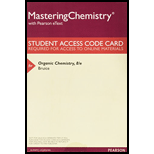
Concept explainers
(a)
Interpretation: To prepare the given products from the reaction of a
Concept introduction: To increase the carbon chain, substituting an alkyl group on alpha carbon of a carbonyl group is called alkylation.
Alkylation is carried out by removing a proton from an alpha carbon with a strong base, LDA, to form an enolate ion and then adding an appropriate alkyl halide. The alkylation is a
(b)
Interpretation: To prepare the given products from the reaction of a ketone with an alkyl halide.
Concept introduction: To increase the carbon chain, substituting an alkyl group on alpha carbon of a carbonyl group is called alkylation.
Alkylation is carried out by removing a proton from an alpha carbon with a strong base, LDA, to form an enolate ion and then adding an appropriate alkyl halide. The alkylation is a
Trending nowThis is a popular solution!

Chapter 17 Solutions
Organic Chemistry - MasteringChemistry
- Starting with cyclohexane, how could the following compounds be prepared?arrow_forwardWrite out the synthesis for each of the following reactions. Show the product and reagents for each step in each synthesis.?arrow_forwardShow how the following compounds can be synthesized from the given starting materials:arrow_forward
 ChemistryChemistryISBN:9781305957404Author:Steven S. Zumdahl, Susan A. Zumdahl, Donald J. DeCostePublisher:Cengage Learning
ChemistryChemistryISBN:9781305957404Author:Steven S. Zumdahl, Susan A. Zumdahl, Donald J. DeCostePublisher:Cengage Learning ChemistryChemistryISBN:9781259911156Author:Raymond Chang Dr., Jason Overby ProfessorPublisher:McGraw-Hill Education
ChemistryChemistryISBN:9781259911156Author:Raymond Chang Dr., Jason Overby ProfessorPublisher:McGraw-Hill Education Principles of Instrumental AnalysisChemistryISBN:9781305577213Author:Douglas A. Skoog, F. James Holler, Stanley R. CrouchPublisher:Cengage Learning
Principles of Instrumental AnalysisChemistryISBN:9781305577213Author:Douglas A. Skoog, F. James Holler, Stanley R. CrouchPublisher:Cengage Learning Organic ChemistryChemistryISBN:9780078021558Author:Janice Gorzynski Smith Dr.Publisher:McGraw-Hill Education
Organic ChemistryChemistryISBN:9780078021558Author:Janice Gorzynski Smith Dr.Publisher:McGraw-Hill Education Chemistry: Principles and ReactionsChemistryISBN:9781305079373Author:William L. Masterton, Cecile N. HurleyPublisher:Cengage Learning
Chemistry: Principles and ReactionsChemistryISBN:9781305079373Author:William L. Masterton, Cecile N. HurleyPublisher:Cengage Learning Elementary Principles of Chemical Processes, Bind...ChemistryISBN:9781118431221Author:Richard M. Felder, Ronald W. Rousseau, Lisa G. BullardPublisher:WILEY
Elementary Principles of Chemical Processes, Bind...ChemistryISBN:9781118431221Author:Richard M. Felder, Ronald W. Rousseau, Lisa G. BullardPublisher:WILEY





